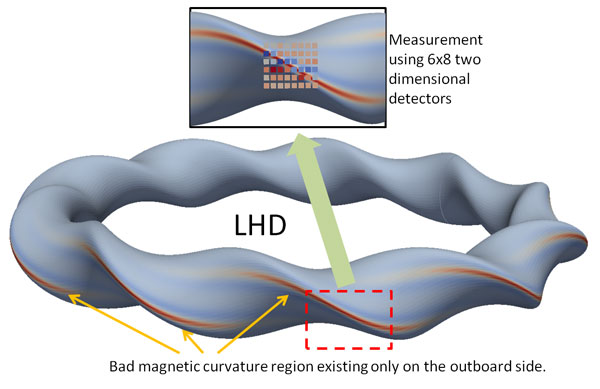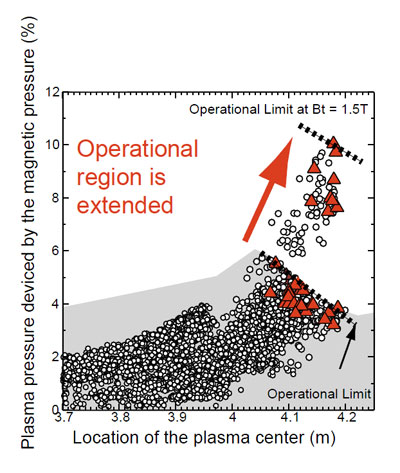HOME > Research Activities > Research Updates >
Acquiring Hints Regarding Improvement of High-density Plasma Performance
The Large Helical Device (LHD) can maintain high-density plasma which other tokamak and other devices cannot attain at the same magnetic field strength as that of other devices. (Regarding the density level, the density is extremely low in comparison to the air density). This is an important superiority of the helical-type over other confinement devices. The extremely high-density plasma generated in the LHD is confined in the core area, and is called Super Dense Core Plasma (SDC). The difference between the pressure in the core area and in the edge region is large, and from a large gradient in the pressure distribution there is concern that plasma instability will occur. Since the 1990s it has been pointed out theoretically that the unusual phenomenon called ballooning instability may possibly occur. In the LHD, a phenomenon having characteristics of the ballooning instability has been observed for the first time, and we have developed a method for preventing that instability.
The “ballooning instability” is an instability in which one part of a plasma expands like a balloon, hence the name. Whether this instability occurs or not is determined primarily by the magnitude of the plasma’s pressure gradient and the condition of the magnetic field container which confines the plasma. In typical experimental conditions, because the plasma repeatedly passes through weak and strong places inside the container the plasma is well confined even when there are weak places in the magnetic field strength. However, when an experiment is conducted in special conditions that permit greatly changing the magnetic field container, in some areas conditions that enable instabilities to easily occur overlap. The toroidal magnetic field container is of a nested surface with an indefinitely large number of layers. The direction of the magnetic field lines changes bit by bit over the nested surfaces. This shear of the magnetic field direction suppresses the plasma expansion. For that reason, in a particular region, when crossing several layers locally the direction of the magnetic field lines becomes uniform and the shear disappears, that part of the plasma becomes swollen. Further, when the “magnetic field curvature (expressing the curving degree of the magnetic field lines)” worsens, this fosters changes in the shape of the plasma. Bad curvature means that the magnetic field is bending convex when seen from the plasma. In the LHD, in the region where these two bad conditions (no shear and bad curvature) overlap, the plasma expands like a balloon, and the ballooning instability occurs. In the LHD’s extreme high-density core plasma, we learned that the region where the bad conditions overlap is in the plasma edge region of the outboard side of the torus, and is the extremely narrow region along the magnetic field lines. When we observed the soft-X radiation being emitted from the plasma, we learned that the plasma shape was deformed in a very narrow region that followed those magnetic field lines.
Further, we learned that when the expansion of a local plasma grows large, the pump-out of heat and particles from the core of the plasma occurs, and that the threshold value of the attainable plasma pressure is determined by whether or not the ballooning instability will occur. By understanding the properties of this instability, we also were able to gain good guidelines for preventing instabilities. Further, based upon those guidelines, by reducing the pressure gradient of edge plasma in which the ballooning instability occurs easily, we avoided the pump-out of heat and particles from the core region, and we were able to raise still higher the plasma pressure in the core region. In this way, by analyzing in detail the mechanisms that destabilize plasma, we were able to obtain hints regarding how to improve the performance of extreme high-density core plasma.

Figure 1: The region where the ballooning instability occurs easily.
The upper enlarged image indicates the magnitude of the plasma displacement measured by the soft-X ray detector. Large displacements are observed along the narrow and long region indicated in red.

Figure 2: Ratio between the plasma pressure and the magnetic pressure (beta value) at the core.
The triangle symbols indicate that the ballooning instability has appeared and the pressure could not be increased further. In the experiment at the magnetic field strength of 1.5T, by reducing the pressure gradient of the plasma edge region the ratio greatly improves.
